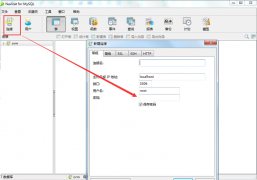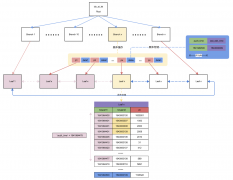一、下载MySQL
http://www.mysql.org/downloads
我下载的是mysql-noinstall-5.0.67-win32.zip
二、安装过程
1、解压缩 mysql-noinstall-5.0.67-win32.zip 到一个C盘,重新命名为 MySQL5 。
假定MYSQL_HOME=C:\ MySQL5
2、编辑mysql的运行配置文件my.ini,如果没有,可以拿my-medium.ini复制然后更名成 my.ini
复制代码代码如下:
# Example MySQL config file for medium systems.
#
# This is for a system with little memory (32M - 64M) where MySQL plays
# an important part, or systems up to 128M where MySQL is used together with
# other programs (such as a web server)
#
# You can copy this file to
# /etc/my.cnf to set global options,
# mysql-data-dir/my.cnf to set server-specific options (in this
# installation this directory is C:\mysql\data) or
# ~/.my.cnf to set user-specific options.
#
# In this file, you can use all long options that a program supports.
# If you want to know which options a program supports, run the program
# with the "--help" option.
# The following options will be passed to all MySQL clients
[client]
#password = your_password
port = 3306
socket = /tmp/mysql.sock
# Here follows entries for some specific programs
# The MySQL server
[mysqld]
basedir = "C:\MySQL5"
datadir = "C:\MySQL5\data"
default-character-set=utf8
port = 3306
socket = /tmp/mysql.sock
skip-locking
key_buffer = 16M
max_allowed_packet = 1M
table_cache = 64
sort_buffer_size = 512K
net_buffer_length = 8K
read_buffer_size = 256K
read_rnd_buffer_size = 512K
myisam_sort_buffer_size = 8M
# Don't listen on a TCP/IP port at all. This can be a security enhancement,
# if all processes that need to connect to mysqld run on the same host.
# All interaction with mysqld must be made via Unix sockets or named pipes.
# Note that using this option without enabling named pipes on Windows
# (via the "enable-named-pipe" option) will render mysqld useless!
#
#skip-networking
# Disable Federated by default
skip-federated
# Replication Master Server (default)
# binary logging is required for replication
log-bin=mysql-bin
# required unique id between 1 and 2^32 - 1
# defaults to 1 if master-host is not set
# but will not function as a master if omitted
server-id = 1
# Replication Slave (comment out master section to use this)
#
# To configure this host as a replication slave, you can choose between
# two methods :
#
# 1) Use the CHANGE MASTER TO command (fully described in our manual) -
# the syntax is:
#
# CHANGE MASTER TO MASTER_HOST=<host>, MASTER_PORT=<port>,
# MASTER_USER=<user>, MASTER_PASSWORD=<password> ;
#
# where you replace <host>, <user>, <password> by quoted strings and
# <port> by the master's port number (3306 by default).
#
# Example:
#
# CHANGE MASTER TO MASTER_HOST='125.564.12.1', MASTER_PORT=3306,
# MASTER_USER='joe', MASTER_PASSWORD='secret';
#
# OR
#
# 2) Set the variables below. However, in case you choose this method, then
# start replication for the first time (even unsuccessfully, for example
# if you mistyped the password in master-password and the slave fails to
# connect), the slave will create a master.info file, and any later
# change in this file to the variables' values below will be ignored and
# overridden by the content of the master.info file, unless you shutdown
# the slave server, delete master.info and restart the slaver server.
# For that reason, you may want to leave the lines below untouched
# (commented) and instead use CHANGE MASTER TO (see above)
#
# required unique id between 2 and 2^32 - 1
# (and different from the master)
# defaults to 2 if master-host is set
# but will not function as a slave if omitted
#server-id = 2
#
# The replication master for this slave - required
#master-host = <hostname>
#
# The username the slave will use for authentication when connecting
# to the master - required
#master-user = <username>
#
# The password the slave will authenticate with when connecting to
# the master - required
#master-password = <password>
#
# The port the master is listening on.
# optional - defaults to 3306
#master-port = <port>
#
# binary logging - not required for slaves, but recommended
#log-bin=mysql-bin
# Point the following paths to different dedicated disks
#tmpdir = /tmp/
#log-update = /path-to-dedicated-directory/hostname
# Uncomment the following if you are using BDB tables
#bdb_cache_size = 4M
#bdb_max_lock = 10000
# Uncomment the following if you are using InnoDB tables
#innodb_data_home_dir = C:\mysql\data/
#innodb_data_file_path = ibdata1:10M:autoextend
#innodb_log_group_home_dir = C:\mysql\data/
#innodb_log_arch_dir = C:\mysql\data/
# You can set .._buffer_pool_size up to 50 - 80 %
# of RAM but beware of setting memory usage too high
#innodb_buffer_pool_size = 16M
#innodb_additional_mem_pool_size = 2M
# Set .._log_file_size to 25 % of buffer pool size
#innodb_log_file_size = 5M
#innodb_log_buffer_size = 8M
#innodb_flush_log_at_trx_commit = 1
#innodb_lock_wait_timeout = 50
[mysqldump]
quick
max_allowed_packet = 16M
[mysql]
no-auto-rehash
# Remove the next comment character if you are not familiar with SQL
#safe-updates
[isamchk]
key_buffer = 20M
sort_buffer_size = 20M
read_buffer = 2M
write_buffer = 2M
[myisamchk]
key_buffer = 20M
sort_buffer_size = 20M
read_buffer = 2M
write_buffer = 2M
[mysqlhotcopy]
interactive-timeout
[mysqld]
# 设置mysql的安装目录
basedir=$MYSQL_HOME
# 设置mysql数据库的数据的存放目录,必须是data,或者是\\xxx\data
datadir=$MYSQL_HOME\data
# 设置mysql服务器的字符集
default-character-set=utf8
[client]
# 设置mysql客户端的字符集
default-character-set=gbk
3、安装mysql服务
从MS-DOS窗口进入目录E:\myserver\mysql-5.0.37-win32\bin,运行如下命令:
mysqld --install mysql --defaults-file=C:\MySQL5\my.ini
4、启动mysql数据库
还在上面的命令窗口里面,输入命令:net start mysql
这样就启动了mysql 服务。
5、停止服务
执行 net stop mysql 即可
6、删除服务
执行mysqld --remove mysql 即可
7、修改密码
以上安装完毕之后,默认的root用户密码为空的。为了安全起见,需要设置一个root用户的密码。
复制代码代码如下:
<STRONG><SPAN style="COLOR: #ffffff" style="COLOR: #ffffff">C:\>cd MySQL5
C:\MySQL5>cd bin
C:\MySQL5\bin>mysql -uroot -p
Enter password:
Welcome to the MySQL monitor. Commands end with ; or \g.
Your MySQL connection id is 3
Server version: 5.0.67-community-log MySQL Community Edition (GPL)
Type 'help;' or '\h' for help. Type '\c' to clear the buffer.
mysql> use mysql
Database changed
mysql> update User set Password=PASSWORD('admin') where User='root';
Query OK, 2 rows affected (0.08 sec)
Rows matched: 2 Changed: 2 Warnings: 0</SPAN>
</STRONG>















